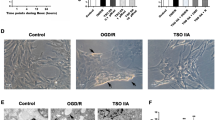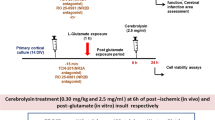Abstract
Excitotoxicity and cytotoxic edema are the two major factors resulting in neuronal injury during brain ischemia and reperfusion. Ca2+/calmodulin-dependent protein kinase II (CaMK II), the downstream signal molecular of N-methyl-d-aspartate receptors (NMDARs), is a mediator in the excitotoxicity. Aquaporin 4 (AQP4), expressed mainly in the brain, is an important aquaporin to control the flux of water. In a previous study, we had reported that pretreatment of simvastatin protected the cerebrum from ischemia and reperfusion injury by decreasing neurological deficit score and infarct area (Zhu et al. PLoS One 7:e51552, 2012). The present study used a middle cerebral artery occlusion (MCAO) model to further explore the pleiotropic effect of simvastatin via CaMK II and AQP4. The results showed that simvastatin reduced degenerated cells and brain edema while decreasing the protein expressions of phosphor-CaMK II and AQP4, and increasing the ratios of Bcl-2/Bax, which was independent of cholesterol-lowering effect. Immunocomplexes formed between the subunit of NMDARs-NR3A and AQP4 were detected for the first time. It was concluded that simvastatin could protect the cerebrum from neuronal excitotoxicity and cytotoxic edema by downregulating the expressions of phosphor-CaMK II and AQP4, and that the interaction between NR3A and AQP4 might provide the base for AQP4 involving in the signaling pathways mediated by NMDARs.






Similar content being viewed by others
Abbreviations
- AQP:
-
Aquaporin
- BWC:
-
Brain water content
- CaMK II:
-
Ca2+/calmodulin-dependent protein kinase II
- MCAO:
-
Middle cerebral artery occlusion
- NMDARs:
-
N-methyl-d-aspartate receptors
- Ser:
-
Serine
- Sim:
-
Simvastatin
- T2WI:
-
T2-weighted imaging
- Thr:
-
Threonine
References
Aoki K, Uchihara T, Tsuchiya K, Nakamura A, Ikeda K, Wakayama Y (2003) Enhanced expression of aquaporin 4 in human brain with infarction. Acta Neuropathol 106:121–124
Badaut J, Ashwal S, Tone B, Regli L, Tian HR, Obenaus A (2007) Temporal and regional evolution of aquaporin-4 expression and magnetic resonance imaging in a rat pup model of neonatal stroke. Pediatr Res 62:248–254
Balami JS, Chen RL, Grunwald IQ, Buchan AM (2011) Neurological complications of acute ischaemic stroke. Lancet Neurol 10:357–371
Choi SS, Seo YJ, Kwon MS, Shim EJ, Lee JY, Ham YO, Lee HK, Suh HW (2005) Increase of phosphorylation of calcium/calmodulin-dependent protein kinase-II in several brain regions by substance P administered intrathecally in mice. Brain Res Bull 65:375–381
Colbran RJ, Schworer CM, Hashimoto Y, Fong YL, Rich DP, Smith MK, Soderling TR (1989a) Calcium/calmodulin-dependent protein kinase II. Biochem J 258:313–325
Colbran RJ, Smith MK, Schworer CM, Fong YL, Soderling TR (1989b) Regulatory domain of calcium/calmodulin-dependent protein kinase II. Mechanism of inhibition and regulation by phosphorylation. J Biol Chem 264:4800–4804
Fukunaga K, Miyamoto E (2000) A working model of CaM kinase II activity in hippocampal long-term potentiation and memory. Neurosci Res 38:3–17
Hudmon A, Schulman H (2002) Structure-function of the multifunctional Ca2+/calmodulin-dependent protein kinase II. Biochem J 364:593–611
Hwang J, Bragado MJ, Duan RD, Williams JA (1996) Protein phosphatase inhibitors potentiate Ca2+/calmodulin-dependent protein kinase II activity in rat pancreatic acinar cells. Biochem Biophys Res Commun 225:520–524
Jung JS, Bhat RV, Preston GM, Guggino WB, Baraban JM, Agre P (1994) Molecular characterization of an aquaporin cDNA from brain: candidate osmoreceptor and regulator of water balance. Proc Natl Acad Sci U S A 91:13052–13056
Kasahara J, Fukunaga K, Miyamoto E (1999) Differential effects of a calcineurin inhibitor on glutamate-induced phosphorylation of Ca2+/calmodulin-dependent protein kinases in cultured rat hippocampal neurons. J Biol Chem 274:9061–9067
Kostandy BB (2011) The role of glutamate in neuronal ischemic injury: the role of spark in fire. Neurol Sci 33:223–237
Lee HK, Choi SS, Han EJ, Han KJ, Suh HW (2003) Role of glutamate receptors and an on-going protein synthesis in the regulation of phosphorylation of Ca2+/calmodulin-dependent protein kinase II in the CA3 hippocampal region in mice administered with kainic acid intracerebroventricularly. Neurosci Lett 348:93–96
Li WZ, Li WP, Huang DK, Kan HW, Wang X, Wu WY, Yin YY, Yao YY (2012) Dexamethasone and Abeta(2)(5)-(3)(5) accelerate learning and memory impairments due to elevate amyloid precursor protein expression and neuronal apoptosis in 12-month male rats. Behav Brain Res 227:142–149
Longa EZ, Weinstein PR, Carlson S, Cummins R (1989) Reversible middle cerebral artery occlusion without craniectomy in rats. Stroke 20:84–91
Miller SG, Patton BL, Kennedy MB (1988) Sequences of autophosphorylation sites in neuronal type II CaM kinase that control Ca2(+)-independent activity. Neuron 1:593–604
Montecucco F, Quercioli A, Mirabelli-Badenier M, Viviani GL, Mach F (2012) Statins in the treatment of acute ischemic stroke. Curr Pharm Biotechnol 13:68–76
Papadopoulos MC, Verkman AS (2007) Aquaporin-4 and brain edema. Pediatr Nephrol 22:778–784
Ponce J, de la Ossa NP, Hurtado O, Millan M, Arenillas JF, Davalos A, Gasull T (2008) Simvastatin reduces the association of NMDA receptors to lipid rafts: a cholesterol-mediated effect in neuroprotection. Stroke 39:1269–1275
Premkumar DR, Mishra RR, Overholt JL, Simonson MS, Cherniack NS, Prabhakar NR (2000) L-type Ca(2+) channel activation regulates induction of c-fos transcription by hypoxia. J Appl Physiol 88:1898–1906
Prinz V, Endres M (2011) Statins and stroke: prevention and beyond. Curr Opin Neurol 24:75–80
Pundik S, Xu K, Sundararajan S (2012) Reperfusion brain injury: focus on cellular bioenergetics. Neurology 79:S44–S51
Rodriguez-Yanez M, Agulla J, Rodriguez-Gonzalez R, Sobrino T, Castillo J (2008) Statins and stroke. Ther Adv Cardiovasc Dis 2:157–166
Saadoun S, Papadopoulos MC (2010) Aquaporin-4 in brain and spinal cord oedema. Neuroscience 168:1036–1046
Sproul A, Steele SL, Thai TL, Yu S, Klein JD, Sands JM, Bell PD (2011) N-methyl-d-aspartate receptor subunit NR3a expression and function in principal cells of the collecting duct. Am J Physiol Ren Physiol 301:F44–F54
Szydlowska K, Tymianski M (2010) Calcium, ischemia and excitotoxicity. Cell Calcium 47:122–129
Taniguchi M, Yamashita T, Kumura E, Tamatani M, Kobayashi A, Yokawa T, Maruno M, Kato A, Ohnishi T, Kohmura E, Tohyama M, Yoshimine T (2000) Induction of aquaporin-4 water channel mRNA after focal cerebral ischemia in rat. Brain Res Mol Brain Res 78:131–137
Tao-Cheng JH, Vinade L, Winters CA, Reese TS, Dosemeci A (2005) Inhibition of phosphatase activity facilitates the formation and maintenance of NMDA-induced calcium/calmodulin-dependent protein kinase II clusters in hippocampal neurons. Neuroscience 130:651–656
Venero JL, Vizuete ML, Ilundain AA, Machado A, Echevarria M, Cano J (1999) Detailed localization of aquaporin-4 messenger RNA in the CNS: preferential expression in periventricular organs. Neuroscience 94:239–250
Verkman AS (2005) More than just water channels: unexpected cellular roles of aquaporins. J Cell Sci 118:3225–3232
Watson C, Paxinos G (2007) The rat brain in stereotaxic coordinates. Academic, Amsterdam
Wayman GA, Tokumitsu H, Davare MA, Soderling TR (2011) Analysis of CaM-kinase signaling in cells. Cell Calcium 50:1–8
Wright SC, Schellenberger U, Ji L, Wang H, Larrick JW (1997) Calmodulin-dependent protein kinase II mediates signal transduction in apoptosis. FASEB J 11:843–849
Yamauchi T (2005) Neuronal Ca2+/calmodulin-dependent protein kinase II—discovery, progress in a quarter of a century, and perspective: implication for learning and memory. Biol Pharm Bull 28:1342–1354
Yang GY, Chen SF, Kinouchi H, Chan PH, Weinstein PR (1992) Edema, cation content, and ATPase activity after middle cerebral artery occlusion in rats. Stroke 23:1331–1336
Yang BF, Xiao C, Roa WH, Krammer PH, Hao C (2003) Calcium/calmodulin-dependent protein kinase II regulation of c-FLIP expression and phosphorylation in modulation of Fas-mediated signaling in malignant glioma cells. J Biol Chem 278:7043–7050
Yang M, Gao F, Liu H, Yu WH, Sun SQ (2009) Temporal changes in expression of aquaporin-3, -4, -5 and -8 in rat brains after permanent focal cerebral ischemia. Brain Res 1290:121–132
Zacco A, Togo J, Spence K, Ellis A, Lloyd D, Furlong S, Piser T (2003) 3-Hydroxy-3-methylglutaryl coenzyme A reductase inhibitors protect cortical neurons from excitotoxicity. J Neurosci 23:11104–11111
Zhu M, Wang J, Liu M, Du D, Xia C, Shen L, Zhu D (2012) Upregulation of protein phosphatase 2A and NR3A-pleiotropic effect of simvastatin on ischemic stroke rats. PLoS One 7:e51552
Acknowledgments
This work was supported by grant from the Second Major Projects of Science and Technology Department in Tibet Autonomous Region.
Conflict of Interest
The authors declare that they have no conflict of interest.
Open Access
This article is distributed under the terms of the Creative Commons Attribution License which permits any use, distribution, and reproduction in any medium, provided the original author(s) and the source are credited.
Author information
Authors and Affiliations
Corresponding author
Rights and permissions
About this article
Cite this article
Zhu, Mx., Lu, C., Xia, Cm. et al. Simvastatin Pretreatment Protects Cerebrum from Neuronal Injury by Decreasing the Expressions of Phosphor-CaMK II and AQP4 in Ischemic Stroke Rats. J Mol Neurosci 54, 591–601 (2014). https://doi.org/10.1007/s12031-014-0307-6
Received:
Accepted:
Published:
Issue Date:
DOI: https://doi.org/10.1007/s12031-014-0307-6




